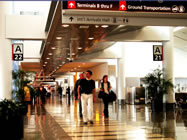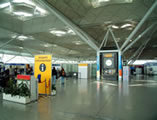Airport Code - What Does It All Mean?
If you are travelling and see the letters LAX, you may automatically know that they are the airport code for the airport in Los Angeles, California. But, do you know what CAK stands for? The code letters given to airports throughout the world have a very specific purpose and are used not only for communication but for safety issues as well.
Definition

A definition of the airport code: The three letters of the code serve as a “location identifier” that is recognised by airports, governments, and security officials all over the world. Every airport has a different code that is unique to it.
How Do Airports Get Their Codes?
 It
can be a very simple process, such as in the case of the Atlanta, Georgia
airport - its code is ATL. However in cities with more than one airport,
multiple cities that are served by the same airport, or for cities that
have the same beginning it gets a little more tricky. For instance, the
Dallas/Fort Worth airport code is DFW. Sometimes the letters match the
name of the airport like JFK for the John F. Kennedy Airport. At other
times, the airport is given an airport code that relates its position east
or west of the Mississippi. With the growth throughout the world, and the
increase in the number of airports there are some changes being made to
the coding system. Now, some airports have 4 letters in their airport code
or a combination of letters and numbers to designate them.
It
can be a very simple process, such as in the case of the Atlanta, Georgia
airport - its code is ATL. However in cities with more than one airport,
multiple cities that are served by the same airport, or for cities that
have the same beginning it gets a little more tricky. For instance, the
Dallas/Fort Worth airport code is DFW. Sometimes the letters match the
name of the airport like JFK for the John F. Kennedy Airport. At other
times, the airport is given an airport code that relates its position east
or west of the Mississippi. With the growth throughout the world, and the
increase in the number of airports there are some changes being made to
the coding system. Now, some airports have 4 letters in their airport code
or a combination of letters and numbers to designate them.
What Is The History Of The Airport Coding System?
 Back
in the early 1900's the National Weather Service assigned two letter codes
to different areas and cities for easy reference and to record weather
information. The first three letter coding system was started back in the
1930's by the International Air Transport Association (IATA.) In the 1930's
as airports began to spring up across the world, a need for an airport
code became evident. For those areas that already had a two letter weather
code, the letter “X” was added to the original two letters
to make the new code - hence, LA became LAX.
Back
in the early 1900's the National Weather Service assigned two letter codes
to different areas and cities for easy reference and to record weather
information. The first three letter coding system was started back in the
1930's by the International Air Transport Association (IATA.) In the 1930's
as airports began to spring up across the world, a need for an airport
code became evident. For those areas that already had a two letter weather
code, the letter “X” was added to the original two letters
to make the new code - hence, LA became LAX.
How Is The Airport Code Used?
 Travellers
use it when they are making reservations for flights and when they are
at the airport to check for flight times, cancellations and delays. Airline
workers such as baggage handlers and check-in attendants, use it to get
your luggage on the correct flight. Pilots use it to notify those who are
watching radar of their destination. The airport code keeps passengers
connected with their luggage, and also keeps the communication between
airports, security personnel and travel agencies, consistent and organised.
Travellers
use it when they are making reservations for flights and when they are
at the airport to check for flight times, cancellations and delays. Airline
workers such as baggage handlers and check-in attendants, use it to get
your luggage on the correct flight. Pilots use it to notify those who are
watching radar of their destination. The airport code keeps passengers
connected with their luggage, and also keeps the communication between
airports, security personnel and travel agencies, consistent and organised.
Are There Any Other Special Rules?
 Yes,
there are many other rules about how the codes are assigned, but one that
you might find interesting is that the United States military petitioned
the government to have a special airport code system designated for them.
Now all military airports have an additional letter on the front. For instance,
Navy airports all have an N at the beginning of their code.
Yes,
there are many other rules about how the codes are assigned, but one that
you might find interesting is that the United States military petitioned
the government to have a special airport code system designated for them.
Now all military airports have an additional letter on the front. For instance,
Navy airports all have an N at the beginning of their code.
Airport coding is something that most of us never think about and probably take for granted a lot of the time. But the truth is, that it has made air travel easier not only for the passengers but for the airline workers, pilots, controllers, and so on. It allows people in different locations, who may speak different languages, to have a basic understanding of the travel system. So, the next time you fly, take a minute to think about the advantages of the coding system.












